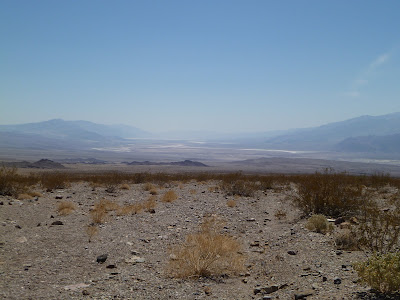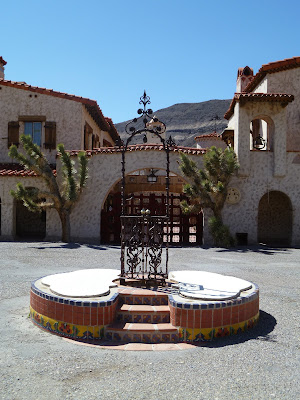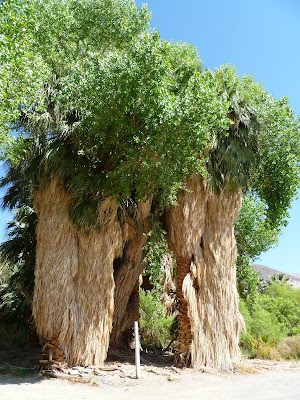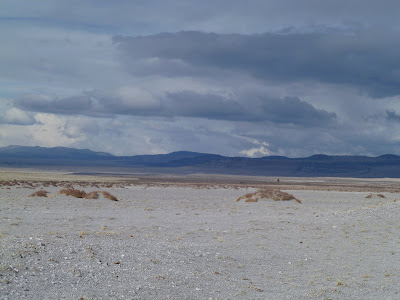This week is Spring Break, so I went to Death Valley with a few uni mates. Originally we were supposed to go to Lassen, which is a volcanic National Park, but changed our plans because of road closures due to snow.Which is kind of a good thing anyway since I've been wanting to see a desert for awhile now.
 This was on the highway on the way there, but I haven't seen so many windmills together before. They're all different sizes. A little puzzled about their efficiency though, since most of them are not moving.
This was on the highway on the way there, but I haven't seen so many windmills together before. They're all different sizes. A little puzzled about their efficiency though, since most of them are not moving.
 Entering the desert area, and we are starting to see some of the interesting rock features. What I like is how the rocks around the desert are all different colours from yellow to red, grey, white and brown, even some greens and purples sometimes. You could collect them and do sand art on adhesive paper like they have for kids.
Entering the desert area, and we are starting to see some of the interesting rock features. What I like is how the rocks around the desert are all different colours from yellow to red, grey, white and brown, even some greens and purples sometimes. You could collect them and do sand art on adhesive paper like they have for kids.
 After 8 hours of driving, we stopped for the day at Lone Pine, which is slightly outside Death Valley. A very small town, but with nice views and very friendly locals. And the motel owner makes very good smelling curry from what I could tell when we were getting our keys from the office.
After 8 hours of driving, we stopped for the day at Lone Pine, which is slightly outside Death Valley. A very small town, but with nice views and very friendly locals. And the motel owner makes very good smelling curry from what I could tell when we were getting our keys from the office.
 This is the main road in Lone Pine, and it's pretty much the whole town already.
This is the main road in Lone Pine, and it's pretty much the whole town already.
 Some old fashioned country structures outside one of the restaurants.
Some old fashioned country structures outside one of the restaurants.
 It's snowing up in the mountains, which is going to feel ironic compared to the desert down here.
It's snowing up in the mountains, which is going to feel ironic compared to the desert down here.
 Near Lone Pine is Owens Lake, a dry salt lake bed.
Near Lone Pine is Owens Lake, a dry salt lake bed.
 It's rare for city folk to see such wide expanses, everything looks amazing.
It's rare for city folk to see such wide expanses, everything looks amazing.
 There's about 1 inch of salt on the ground, and it crunches when you walk on it.
There's about 1 inch of salt on the ground, and it crunches when you walk on it.

 It seems so idyllic to live out here, although I can't tell what you could make your living doing. Maybe something to do with mining.
It seems so idyllic to live out here, although I can't tell what you could make your living doing. Maybe something to do with mining.
 Right about here our GPS led us through a wrong road heading towards the Badwater Basin; a dirt road instead of tarred, which was a lot scarier than it sounds.The (second-hand) car that we were using had a very low belly, so it was scraping the road all the way and seemed likely to break down at any moment/loose some parts on the road, and not knowing the way around the gulch, with a GPS we couldn't really trust, it was a very stressful journey. Maybe I watch too much I Shouldn't be Alive, but that's what I kept thinking about. In the end we managed to turn around and find our way back to the tarred road, but I think at least the car was scarred for life.
Right about here our GPS led us through a wrong road heading towards the Badwater Basin; a dirt road instead of tarred, which was a lot scarier than it sounds.The (second-hand) car that we were using had a very low belly, so it was scraping the road all the way and seemed likely to break down at any moment/loose some parts on the road, and not knowing the way around the gulch, with a GPS we couldn't really trust, it was a very stressful journey. Maybe I watch too much I Shouldn't be Alive, but that's what I kept thinking about. In the end we managed to turn around and find our way back to the tarred road, but I think at least the car was scarred for life.
 We stopped for lunch at Stovepipe Wells village, which had this charming restaurant.
We stopped for lunch at Stovepipe Wells village, which had this charming restaurant.
 Granted things were a little bizarre since there was a motel swimming pool right outside,with tons of happy splashing tourists, surrounded by sand dunes and scorching hot rocky mountains.
Granted things were a little bizarre since there was a motel swimming pool right outside,with tons of happy splashing tourists, surrounded by sand dunes and scorching hot rocky mountains.
 Next stop, Zabriskies Point, with it's inspiring rock formations.
Next stop, Zabriskies Point, with it's inspiring rock formations.



 Someone made it down there, perhaps if it wasn't so hot and I was more daring I would want to go down there too.
Someone made it down there, perhaps if it wasn't so hot and I was more daring I would want to go down there too.
 In the evening we reached Badwater Basin, by the prescribed tarred road thankfully. It is the most famous salt bed in Death Valley, and the lowest point in the US (it's 86 meters below sea level)
In the evening we reached Badwater Basin, by the prescribed tarred road thankfully. It is the most famous salt bed in Death Valley, and the lowest point in the US (it's 86 meters below sea level)
 It looks like a giant ice rink except for little patches of water at the edges. Apparently some snails can live in here, of all creatures.
It looks like a giant ice rink except for little patches of water at the edges. Apparently some snails can live in here, of all creatures.
 There would be pretty rings of salt on the ground were it not trampled flat by tourists. Walking further out you get to see a vague outline of what the rings should look like.
There would be pretty rings of salt on the ground were it not trampled flat by tourists. Walking further out you get to see a vague outline of what the rings should look like.

 Like this apparently.
Like this apparently.

 Sunset. It would have been nice to watch the starlight from Badwater basin since light pollution here is supposed to be minimal.
Sunset. It would have been nice to watch the starlight from Badwater basin since light pollution here is supposed to be minimal.
 The good, or bad, thing is that there is a lot of driving to be done to get from one point of interest to another around the desert. I guess you could have fun pretending you are driving in a car commercial or video game, there are quite few vehicles on the road.
The good, or bad, thing is that there is a lot of driving to be done to get from one point of interest to another around the desert. I guess you could have fun pretending you are driving in a car commercial or video game, there are quite few vehicles on the road.
 New day, new location, new motel.
New day, new location, new motel.
 I found this funny, a faded old beetle, but with what looks like specialised tires and a huge exhaust pipe sticking out of the back.
I found this funny, a faded old beetle, but with what looks like specialised tires and a huge exhaust pipe sticking out of the back.
 The motel had some cotton trees, so it was a nice surprise to wake up the next day to what looked like snow, or a burst pillow.
The motel had some cotton trees, so it was a nice surprise to wake up the next day to what looked like snow, or a burst pillow.
 They look much prettier swirling around in the wind. Maybe if I have a house with a garden I should have a cotton tree too.
They look much prettier swirling around in the wind. Maybe if I have a house with a garden I should have a cotton tree too.
 Not sure what this place is called, we just stopped here to get maps,but it looks pretty.
Not sure what this place is called, we just stopped here to get maps,but it looks pretty.
 Scotty's Castle, which is really a mansion. Unfortunately we didn't take the tour inside the building since the ticket price was a little steep, but we walked around it anyway.
Scotty's Castle, which is really a mansion. Unfortunately we didn't take the tour inside the building since the ticket price was a little steep, but we walked around it anyway.




 Look, an air con in the toilet!
Look, an air con in the toilet!

 Some local fauna. A metallic blue wasp.
Some local fauna. A metallic blue wasp.
 Mesquite Flat sand dunes. Apparently they shot some scenes for Star Wars here.
Mesquite Flat sand dunes. Apparently they shot some scenes for Star Wars here.
 It's actually just a small dune, but it was a fun experience to walk in the sand. The wind was very strong, but all the better to see sand flowing around your feet.
It's actually just a small dune, but it was a fun experience to walk in the sand. The wind was very strong, but all the better to see sand flowing around your feet.
 Dinner, at a very manly man named restaurant.I can't think of any other words to add to the sign to make it more macho.
Dinner, at a very manly man named restaurant.I can't think of any other words to add to the sign to make it more macho.
 Night number 3, we'll be staying here. Motel 6 is the ubiquitous low cost motel in the US, so it's perfect for cheapskate students like us.
Night number 3, we'll be staying here. Motel 6 is the ubiquitous low cost motel in the US, so it's perfect for cheapskate students like us.
 The next day, and the forecast is rain. That creates a pleasant image of flowers blooming around the desert, but before that it also brings epically beautiful scenery.
The next day, and the forecast is rain. That creates a pleasant image of flowers blooming around the desert, but before that it also brings epically beautiful scenery.

 We're on the Nevada side of Death Valley, so prostitution is legal, along with gambling.
We're on the Nevada side of Death Valley, so prostitution is legal, along with gambling.

 And the rain is falling.
And the rain is falling.





 On the way back, the GPS decided to give us a longer route to get back to San Francisco, which somehow involves going through Yosemite and Lake Tahoe. Another happy mistake since the scenery was much more interesting than the empty fields we passed on day 1. This is Mono Lake near Yosemite.
On the way back, the GPS decided to give us a longer route to get back to San Francisco, which somehow involves going through Yosemite and Lake Tahoe. Another happy mistake since the scenery was much more interesting than the empty fields we passed on day 1. This is Mono Lake near Yosemite.



 But in the end we were forced to stay an extra night in Lake Tahoe because of road closures due to snow. It was too dangerous to drive without a 4 wheel drive/snow tires/chains not to mention highway patrol wouldn't let you pass.
But in the end we were forced to stay an extra night in Lake Tahoe because of road closures due to snow. It was too dangerous to drive without a 4 wheel drive/snow tires/chains not to mention highway patrol wouldn't let you pass.
 So we get to see the desert, forest and snowscape in 1 trip. Not bad. Luckily I was paranoid enough about desert weather to pack winter worthy clothes.
So we get to see the desert, forest and snowscape in 1 trip. Not bad. Luckily I was paranoid enough about desert weather to pack winter worthy clothes.

 An interesting plant common around here. The tips are redder or more yellow than the base. Kind of looks like pussy willow.
An interesting plant common around here. The tips are redder or more yellow than the base. Kind of looks like pussy willow.
 The snow clouds retreating from Lake Tahoe.
The snow clouds retreating from Lake Tahoe.
 Some cold birds taking a break.
Some cold birds taking a break.
~~~~~~
Too bad we missed these 2 things in Death Valley; the Racetrack Playa with it's mysterious travelling stones(dirt road,no more car abuse for us please) and the pupfish that live in the super harsh conditions of the desert.(don't know where exactly they are)